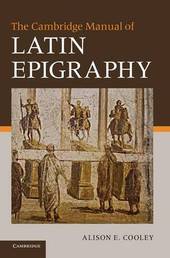
|
The Cambridge Manual of Latin Epigraphy
Hardback
Main Details
| Title |
The Cambridge Manual of Latin Epigraphy
|
| Authors and Contributors |
By (author) Alison E. Cooley
|
| Physical Properties |
| Format:Hardback | | Pages:554 | | Dimensions(mm): Height 253,Width 180 |
|
| Category/Genre | Classical Greek and Roman archaeology |
|---|
| ISBN/Barcode |
9780521840262
|
| Classifications | Dewey:937 |
|---|
| Audience | | Professional & Vocational | | Tertiary Education (US: College) | |
|---|
| Illustrations |
1 Maps; 75 Halftones, unspecified; 25 Line drawings, unspecified
|
|
Publishing Details |
| Publisher |
Cambridge University Press
|
| Imprint |
Cambridge University Press
|
| Publication Date |
13 September 2012 |
| Publication Country |
United Kingdom
|
Description
This book advances our understanding of the place of Latin inscriptions in the Roman world. It enables readers, especially those new to the subject, to appreciate both the potential and the limitations of inscriptions as historical source material, by considering the diversity of epigraphic culture in the Roman world and how it has been transmitted to the twenty-first century. The first chapter offers an epigraphic sample drawn from the Bay of Naples, illustrating the dynamic epigraphic culture of that region. The second explores in detail the nature of epigraphic culture in the Roman world, probing the limitations of traditional ways of dividing up inscriptions into different categories, and offering examples of how epigraphic culture developed in different geographical, social and religious contexts. It examines the 'life-cycle' of inscriptions - how they were produced, viewed, reused and destroyed. Finally, the third provides guidance on deciphering inscriptions face-to-face and handling specialist epigraphic publications.
Author Biography
Alison E. Cooley is Reader in Classics and Ancient History at the University of Warwick. She has published extensively on topics relating to Roman epigraphy. She has edited three books and most recently published an edition and commentary on the 'queen of inscriptions', Res Gestae Divi Augusti (Cambridge University Press, 2009). She has taught epigraphy to postgraduates attending the British Epigraphy Society's international summer school, as well as at Oxford and Warwick. She is also a member of the team producing quinquennial survey articles on inscriptions and Roman studies for the Journal of Roman Studies.
|